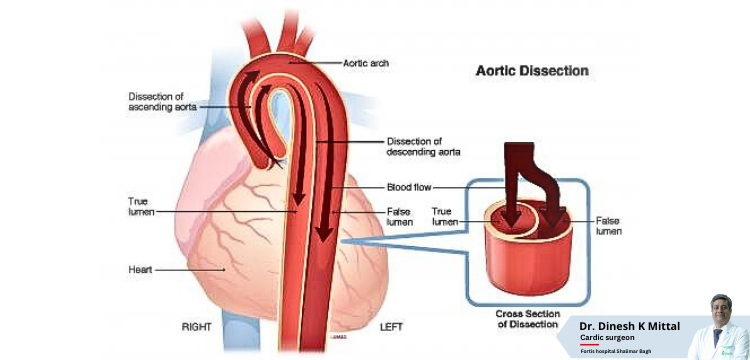Aortic Dissection Treatment in Delhi | Dr. Dinesh Kumar Mittal

Understanding how things work inside can sometimes be challenging in keeping the human body healthy. One super important part of the body is the aorta. It’s like a superhighway for blood, carrying everything needed to stay alive to every part of our body.
But what happens when this critical highway has problems? Well, that’s when aortic dissection comes into play. It’s a big issue that can occur without making much noise. If nothing is done soon, it might lead to disastrous consequences.
So, As a result, this blog will understandably discuss aortic dissection. This is designed to assist in understanding the basics of aortic dissection, whether one is just curious or wants to know more about this heart disease.
What is Aorta?
Aorta is the blood supply line for the whole body. It is like a hose pipe from the heart traveling through the neck, chest, and abdomen, supplying blood to all the organs.
Aortic dissection is a challenging heart condition that requires a specialist to treat. Dr. Dinesh Kumar Mittal sheds light on this condition’s complexities and solutions in the following discussion.
What are the Common Causes of Aortic Dissection?
Aortic dissection is one of the life-threatening heart complications in medical science. The specific cause of aortic dissection is not found yet, but some common risk factors can put the person near the red line.
In the words of Dr. Mittal, “Many things weaken the aorta wall, which leads the person to suffer from dissection. There are some genetic conditions in which the body’s tissue grows abnormally, such as untreated hypertension, connective tissue disorders like Marfan syndrome, atherosclerosis, and other chest infections. Also, accidental injuries to the chest area can damage the aorta tissue.”
What are the General Types of Aortic Dissection?
The aorta transports blood from the human heart to the body. It travels from the bottom to the upward direction, generally known as the ascending aorta, and it also travels up to the downward movement, known as the descending aorta. Aortic move can happen in any part of the aorta or even both of the aspects of it.
- Type A: Type A dissection means the rupture involves your ascending aorta, regardless of where the initial fracture occurs.
- Type B: Dissections starting in the descending aorta are considered type B. If they do not involve the ascending aorta, they are less life-threatening than type A dissection.
Whether Type A or Type B, Dr. Mittal is prepared to deliver the proper therapy at the vital moment, armed with his skills and experience.
“My life’s work has been dedicated to assisting patients with heart-related difficulties,” adds Dr. Mittal. You can count on me to deliver the finest possible treatment, whether a Type A or Type B dissection.”
What Key Factors Can Push the Risk of Aortic Dissection?
Both men and women are on the equal risk edge of this condition. The typical age for aortic dissection is between 50 to 65 years. Men are closer to the risk as the reports show that two-thirds of the patients are male who are suffering from this condition. However, the impact on health is worsening for women.
Here are the common factors that can lead you to face this disease –
- High blood pressure: If a person experiences high blood pressure for a long time, his body is more likely to suffer from this condition. High blood pressure creates more pressure on the artery walls.
- Certain Genetic Disorders: People with certain genetic conditions are at higher risk of aortic dissection. The genetic condition includes:
- Turner Syndrome
- Marfan Syndrome
- Ehlers-Danlos Syndrome
- Chest trauma: If a person suffers a severe chest injury that damages the aorta, it can lead to aortic dissection.
- Excess use of cocaine: If a person takes a high dose of cocaine, it can also make them closer to the risk of aortic dissection. The high cocaine intake puts pressure on the blood and makes the situation worse for the individuals.
- High-Intensity Lifting: People who involve themselves in heavy and intense workout sessions and exercise are closer to the health risk of this condition. Intense workouts increase the pressure on the blood of the body.
Dr. Dinesh Kumar Mittal is all too familiar with these risk factors. His knowledge is handy when dealing with aortic dissection patients. He understands that early detection and treatment may make all the difference. His dedication to assisting individuals with cardiac problems is unshakeable.
Sarah’s experience is just one of many stories from patients under the care of Dr. Mittal. Sarah expresses, “I consider myself fortunate to have had Dr. Dinesh Kumar Mittal as my cardiologist during my aortic dissection ordeal. His expertise and prompt action unquestionably saved my life. Dr. Mittal’s profound grasp of the condition and his unwavering commitment to patient care significantly impacted my recovery. I am deeply thankful for his exceptional medical care and unwavering support.”
What are Some Major Complications of Aortic Dissection?
Identification of aortic dissection is difficult as its symptoms are similar to other heart diseases. Aortic dissection can cause severe damage to the organs quickly, so taking too much time in the treatment process will put the patient’s life in danger. Below are the complications that the patients experience –
- Rupture of the aorta
- Cardiac Tamponade
- Heart attack
- paralysis
- Aortic regurgitation
- organ failure
- gangrene intestine
Is Aortic Dissection Life Threatening?
Aortic dissection is a life-threatening medical problem that can make things turn out to be worse for the patients, even leading to scenarios like sudden death. The condition involves a tear in the aorta’s inner layer, which can cause fatal internal bleeding, compromised blood flow to organs, organ damage, and shock. Taking immediate action is the best way to eliminate this and enhance the chances of survival and a better health outcome.
Yet, in the direst of circumstances, like dealing with a life-threatening condition such as aortic dissection, the presence of a skilled and devoted physician like Dr. Dinesh Mittal can genuinely be the deciding factor that can change everything for the better.
Can Aortic Dissection be Cured?
Aortic dissection is one of the critical medical conditions that can be treated and cured if the patients take immediate action towards the situation within the time. Quick action on the condition ensures that the person is exempted from further organ damage, reducing complications and risks. Most important is that it saves the life of the patients if treated promptly. Also, the specific treatment approach, surgeon patterns, and the patient’s overall health play a significant role in enhancing the success rate of the treatment.
How Much Does an Aortic Dissection Cost in Delhi NCR?
The cost of Aortic Dissection Repair Surgery in India ranges from Rs.355200 to Rs.473600 for Indian patients. For international patients, it is between USD 7200 and USD 8800. The cost of the treatment, however, may vary by the diagnosis and facilities chosen by the patient.
Aortic dissection is a reminder to take a quick and accurate intervention. Understanding and awareness of this condition will help individuals get adequate and timely medical support. Any delay in taking the right treatments can drastically trouble the patient’s health and even cause sudden death. Knowing the significant risk factors can alert individuals to act on their health condition immediately. It’s the life-threatening battle between life and death; your one right move and decision can save energy. Therefore, having a skilled and experienced physician like Dr. Dinesh Kumar Mittal can significantly enhance the chances of a successful outcome.
Frequently Asked Questions (FAQs)
1. Is aortic dissection preventable?
Managing high blood pressure, getting help for hereditary problems, and abstaining from heavy cocaine use can lower the chance of aortic dissection. It might not always be prevented, though.
2. What typical signs of an aortic dissection are there?
A sudden and intense chest pain, shortness of breath, radiating back discomfort, loss of consciousness, and other symptoms are frequently present. However, signs can change.
3. How is the aortic dissection determined?
Imaging studies like CTs and medical histories with physical examinations are frequently used in diagnosis.
4. What percentage of aortic dissection operations succeed?
The type of dissection, the patient’s health, and the surgeon’s skill are some variables that affect the success rate. With your healthcare practitioner, go through this.
5. Can an aortic possibly occur after treatment?
Recurrence is a possibility, although the risk can be reduced with your healthcare team giving long-term care advice will be provided by your healthcare team.
